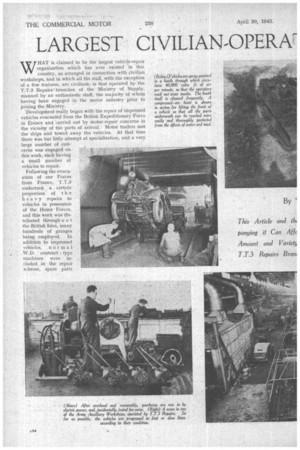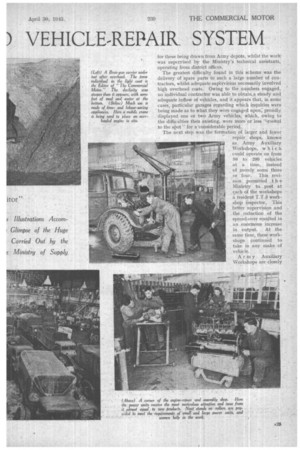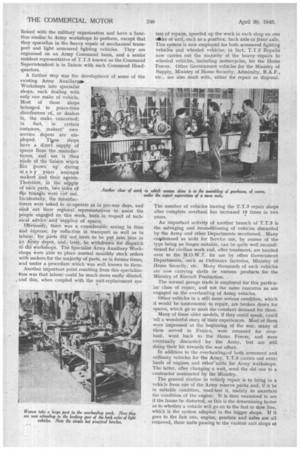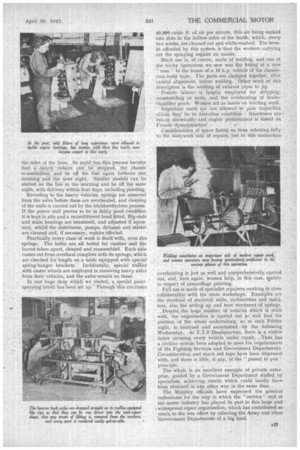LARGEST CIVILIAN-OPERK ) VEHICLE-REPAIR SYSTEM
Page 26

Page 27

Page 28

Page 29

If you've noticed an error in this article please click here to report it so we can fix it.
WHAT is claimed to be the largest vehicle-repair organization which has ever existed in this country, as arranged in connection with civilian workshops, and in which all the staff, with the exception of a few trainees, are civilians, is that operated by the T.T.3 Repairs, branches of the Ministry of Supply, manned by an enthusiastic staff, the majority of whom having been engaged in the motor industry prior to joining the Ministry.
Development really began with the repair of impressed , vehicles evacuated from the British Expeditionary Force
. in France and -carried out by motor-repair concerns in the vicinity of the ports of arrival. Motor traders met the ships and towed away the vehicles. At that time there was but little attempt at specialization, and a very large number of concerns was engaged on this work, each having a small number of vehicles to repair.
. Following the evacuation of our Forces from France, T. T-3 undertook a certain proportion of t h e Ii eavy repairs to vehicles in possession of the Home Forces, and this work was distributed through o u t the British Isle's, many hundreds of garages being employed. In addition to impressed vehicles, normal W.D. ' contract type machines were included .in the repair scheme, spare parts
for these being drawn from Army depots, whilst the work was superyised by the Ministry's technical assistants, operating from district offices.
The greatest difficulty found in this scheme was the delivery of spare parts to such a large number of contractors, whilst adequate supervision necessarily involved high overhead costs. Owing to the numbers engaged, no individual contractor was able to obtain,a steady and adequate inflow of vehicles, and it appears that, in some cases, particular garages regarding which inquiries were ' being made as to what they were engaged upon; proudly displayed one or two Army vehicles, which, owing to the difficulties then existing, were more or less "-rooted to the spot" for a'considerable period.
The next step was the formation of larger and fewer repair shops, known
as Army Auxiliary Workshops, whic is could operate on from 50 to 200 vehicles at a time, instead of merely some three or four. This revi
• sion permitted t h e Ministry to. post at each of the workshops a resident T.T.3 workshop inspector. This better supervision and the _reduction of the spread-over resulted in an enormous increase in output. At the same time, these workshops continued to take in any make of vehicle.
Army Auxiliary Workshops are closely
-linked with the military organization and have a function similar to Army workshops to perform, except that they specialize in the heavy repair. of mechanical transport and light armoured fighting vehicles. They are organized on an Army Command basis, and a senior resident representative of T.T.3 known as the Command Superintendent is in liaison with each Command Headquarters.
A further step was the development of some of the existing Army Auxiliary*
Workshops into specialist shops, each dealing with only one make of vehicle. Most of these 'shops belonged, to peace-time distributors of,. or dealers in, the mike concerned; in fact, in certain instances, makers'. own service depots are employed. Tlipse shops have a direct supply of Spares from the manufacturers, and use is ,thus Made of the liaison which làsgroWn uP' during a n y , 'Years amongst maker and their agents. . Therefore, in the supply of such parts,, two sides of the triangle Were 'cut out. Incidentally, the manufacturers were asked to co-operate as in pm-war days, and se-rict out their regional representatives to assist the people engaged on this work, both in respect of technical advice and 'supplies of spares. • Obviously, there was a considerable saving in time and expense, by reduction in transport as well as in labour; for Parts did not have to be put into bins in an A-my dept, and:later, be withdrawn for dispatch the.vioAshoPs. The Specialist Army Auxiliary Workshops Were able to place normal monthly stock orders with makers for the majority of parts, as in former times, and under a procedure which was well known to them.
Another important point resulting from this specialization was that labour could be much more easily diluted, and this, when coupled with the unit-replacement sys . tern of repairs, speeded up the work in each shop on one rake of unit, such as a gearbox, back axle or front axle, This system is now employed for both armoured fighting vehicles and wheeled vehicles; in fact, T.T.3 Repairs now carries out the majority of the heavy repairs to wheeled vehicles, including motorcycles, for the Home Forces. Other Government vehicles for the Ministry of Supply, Ministry of Home Security; Admiralty, R.A.F., etc., are also dealt with, either for repair or disposal.
The number of vehicles leaving the I.T.3 repair shops after complete overhaul has increased 10 times in two years.
. An important activity of another branch of T.T.3 is the salvaging and reconditioning of vehicles discarded' by the Army and other Departments mentioned. Many condemned as unfit for Service use, by reason of the type being no longer suitable, can be quite well reconditioned for civilian work and, after treatment, are handed over to the M.O.W.T. for use by other Government Departments,such as Ordnance factories, Ministry of Home Security; etc. Many thousands of such vehicles are now carrying shells or various products for the Ministry of Aircraft Production.
The normal garage trade is employed for this particular class of repair, and not the same concerns as are engaged on the overhauling of Army vehicles, Other vehicles in a still more serious condition, which it would be uneconomic to repair, are broken down for spares, which go to meet the constant demand for these.
Many of these older models, if they could speak, could tell a wonderful story of their experiences. Most of them were impressed at the beginning of the war, many of them served in France, were returned for overhaul, went back to the Home Forces, and were eventually discarded by the Army, but are still doing their bit towards the war effort.
In addition to the overhaulingtof both armoured and ordinary vehicles for the Army, T.T.3 carries out overhauls of engines and other'units for Army workshops. The latter, after changing a unit, send the old one to a contractor nominated by the Ministry.
The general routine in vehicle repair is to bring in a vehicle from one of the Army reserve parks and, if it be in suitable condition, road-test it, mainly to ascertain the condition of the engine. It is then examined to see if the frame be distorted, as this is the determining factor as to whether a vehicle will go on to the fast or slow line, which is the system adopted in the bigger shops. If it goes to the fast one, engine, gearbox and axles are all removed, these units passing to the various unit shops at the sides of the lines. ..So rapid has this process become that a •hea% '37...vehicle can be striPped, the chassis re-assembled, and be off the line again between one morning and the next -night.' &nailer -modeli can be started MI the line-iii the morning and be off the same night, with delivery within four days, including painting. Reverting to the heavy vehicles, springs are removed from the axles before these are overhauled, and cleaning of the units is carried out by the.trichlorethylene process. If the power unit proves to be in fairly good condition it is kept in situ and a reconditioned head fitted. Big ends and main bearings are examined, and adjusted if necessary, whilst the distributor, pumps, dyhamo and starter are cleaned and, if necessary, repairs effected, Practically every class of work is dealt with, even the. springs. The latter are all tested for camber and the leaves taken apart, cleaned and reassembled. Each axle comes out from overhaul complete with its springs, which are checked for length on a table equipped with Special spring-hanger brackets. Incidentally, special trollies with castor wheels are employed in removing heavy aides from their vehicles, and the axles remain on these.
• In one huge shop which we -visited, a special paintspraying booth has been set up.Through this circulates 40,000 cubic ft. of .air per minute, this air being sueked into slots in the hollow sides of the booth, which, every two weeks, are cleaned out and white-washed. The benefit afforded by this system is that the workers carrying out the spraying require no masks. .
Much use is, of course, made of welding, and one of the tricky operations we saw was the fitting of a new " nose " to the frame Of a 10 h.p. vehicle Of the. chassiscum-body type. The parts are clamped together, after careful alignment, before welding. Other work of this description is the welding -of exhaust pipes to jig. • Female labour is largely employed for stripping, -reassembling of units, and the overhauling of brakeexpander gears, Women act as Mates on erecting work.
Irripbrtant units are not allowed to pass 'inspection nilless they be in first-class condition. Gearboxes are • run-in electrically and:engine •perforinanee is tested on Fronde dynarriOmeters Considerations of space forbid us from referring fully to the bodywork' side of repairs; but in this connection overhauling is just as 'well and comprehensiyely. carried out, and, here again, women help, in this case, vainly in respect of camouflage painting.
• Full use is made of specialist repairers working in close collaboration with the main workshops. Examples are the overhaul of electrical units, .carburetters and radiv tors, also the .setting up and heat treatment of springs. Despite, the, huge number of vehicles which is dealt with, the organization is carried out so well that the position of the whole undertaking, as at each Friday night, is analysed and ascertained by the following Wednesday. .At.T.T.3 Headquarters, there is a visible index covering 'every vehicle under repair. , .Thus has a civilian system been adopted to meet the requirements of the Fighting Services and Government Department. Circumlocution and much red tape have been dispensed with, and there is little, if any, of the "passed to you " principle.
The whole is an excellent example of private enterprise, guided' by a Government Department staffed, by' specialists, achieving results which could hardly have been obtained in any other way in the same time.
The Ministry officials have expressed the greatest enthusiasm for the way in which the " service " end of the motor industry has played its part in this large and .widespread repair organization, Which has contributed so much, to the war effort by relieving the Army and other • Government Departments of a big load.




















































